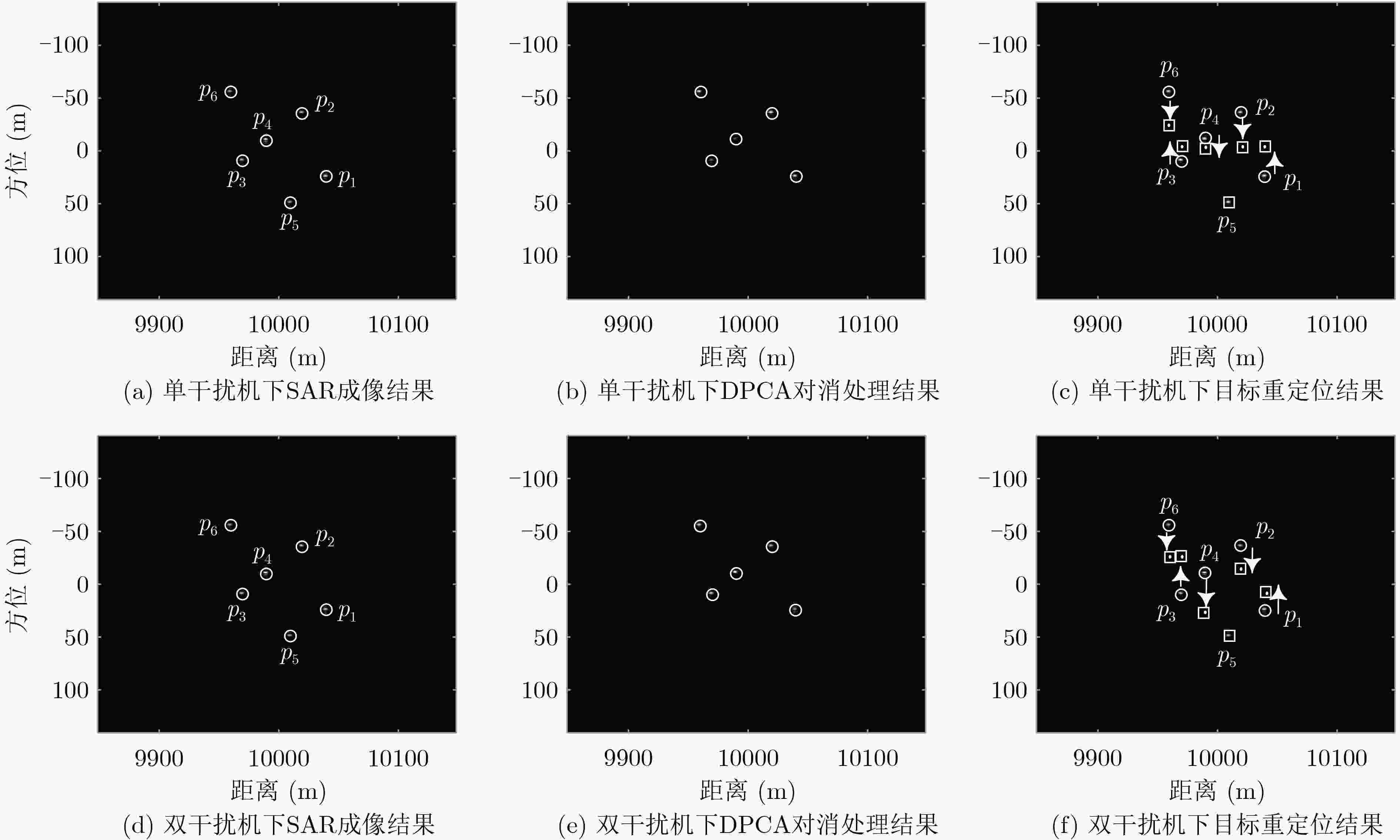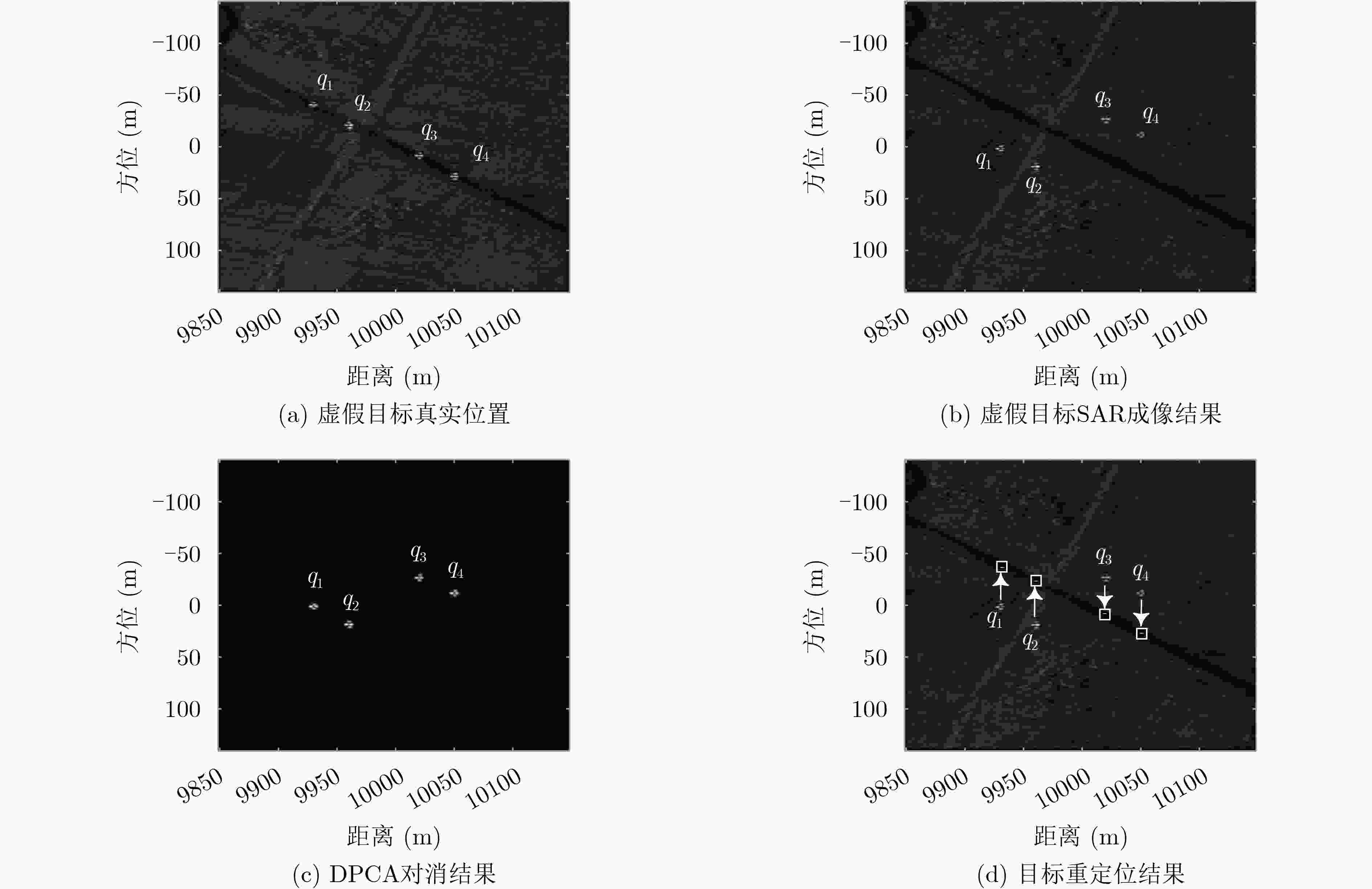A Fasle Moving Target Generation Method Based on Coherent Two-point Resouce
-
摘要: 针对传统的2维移频干扰生成的虚假运动目标对抗双通道合成孔径雷达地面运动目标指示(SAR-GMTI)时,存在方位位置固定、径向速度无法控制的问题,该文提出一种基于双干扰机协同的移频调制新型虚假运动目标生成方法。该方法通过2维移频调制控制虚假目标的位置,使用双干扰机协同控制虚假目标的径向速度,其中双干扰机通过幅相调制系数进行协同,幅相调制系数可通过解线性方程组进行求解。文中分析了单干扰机移频干扰对抗双通道SAR-GMTI的局限性,介绍了双干扰机协同欺骗干扰模型,给出了幅相调制系数求解方法和虚假运动目标生成步骤。理论分析和仿真实验验证了文中提出方法的有效性,并且在虚假运动目标生成过程中,只使用了2维移频调制,实现方法较为简单,对实际工程应用具有一定参考价值。Abstract: Focusing on the problem that the azimuth position is fixed and the radial velocity can not be controlled when the false moving target generated by the traditional two-dimensional shift-frequency jamming against the dual-channel Synthetic Aperture Radar-Ground Moving Target Indication (SAR-GMTI), a new type of false moving target generation method with shift-frequency modulation based on the cooperation of dual jammers is proposed. This method uses two-dimensional shift-frequency modulation to control the position of the false target and uses dual synergetic jammers to control the radial velocity of the false moving target. The dual jammers coordinate through the amplitude and phase modulation coefficients, which can be solved by solving linear equations. In this paper, the limitation of single jammer shift-frequency jamming against dual-channel SAR-GMTI is analyzed, the dual jammer cooperative deception jamming model is introduced, the method for solving amplitude and phase modulation coefficients is explained, and the steps of generating false moving targets is given. Theoretical analysis and simulation experiment verify the effectiveness of the proposed method. And in the process of generating false moving targets, only two-dimensional shift-frequency modulation is used, so the method is relatively simple to achieved, and can offer certain reference value for practical engineering applications.
-
表 1 两通道 SAR-GMTI系统参数
参数 数值 载频 10 GHz 调频带宽 70 MHz 平台速度 200 m/s 采样频率 100 MHz 脉冲重频 500 Hz 成像中心斜距 10000 m 基线长度 3.2 m 表 2 不同干扰方法下目标的径向速度估计和方位位置估计
干扰机布置 目标 径向速度 方位位置 估计
$ {\hat v_r} $ (m/s)误差
(m/s)估计
$ \hat x $ (m)位置偏移
$ - {R_0}{\hat v_r}{\text{/}}{V_a} $ (m)重定位
(m)误差
(m)单干扰机 $ {p_1} $ –0.5179 – 25.10 25.90 –0.80 –10.80 $ {p_2} $ 0.6863 – –35.00 –34.31 0.69 10.69 $ {p_3} $ –0.2164 – 10.00 10.82 –0.82 19.18 $ {p_4} $ –0.6164 – –9.40 –9.21 –0.19 –30.19 $ {p_{\text{5}}} $ –0.016 –0.016 50.10 0.80 49.30 –0.70 $ {p_{\text{6}}} $ 0.6827 –0.0173 –54.80 –34.14 –20.64 –0.64 双干扰机 $ {p_1} $ –0.3431 –0.0431 25.40 17.16 8.24 –1.76 $ {p_2} $ 0.4817 –0.0183 –35.00 –24.08 –10.92 –0.92 $ {p_3} $ –0.6174 –0.0174 10.00 30.87 –20.87 –0.87 $ {p_4} $ 0.7366 –0.0634 –9.40 –36.83 27.43 –2.57 表 3 不同双干扰机干扰方法下目标的径向速度估计和方位位置估计
条目 径向速度$ {\hat v_r} $(m/s) $ {p_1} $ $ {p_2} $ $ {p_3} $ $ {p_4} $ 本文双干扰机方法 估计值 –0.3027 0.5307 –0.5906 0.7846 误差 –0.0027 0.0307 0.0094 –0.0154 传统双干扰机方法 估计值 –0.3022 0.5401 –0.5697 0.7845 误差 –0.0022 0.0401 0.0303 –0.0155 表 4 静止场景下目标的径向速度估计和方位位置估计
目标 径向速度 方位位置 估计
$ {\hat v_r} $ (m/s)误差
(m/s)估计
$ \hat x $ (m)位置偏移
$ - {R_0}{\hat v_r}{\text{/}}{V_a} $ (m)重定位
(m)误差
(m)$ {q_1} $ –0.8160 –0.0340 2.40 40.80 –38.40 1.60 $ {q_2} $ –0.8321 –0.0321 19.90 41.61 –21.71 –1.71 $ {q_3} $ 0.6119 –0.0881 –25.00 –30.60 5.60 –4.40 $ {q_4} $ 0.7811 0.0189 –9.90 –39.06 29.16 –0.84 -
[1] CUMMING I G and WONG F H. Digital Processing of Synthetic Aperture Radar Data: Algorithms and Implementation[M]. Boston: Artech House, 2005: 3–17. [2] 李永祯, 黄大通, 邢世其, 等. 合成孔径雷达干扰技术研究综述[J]. 雷达学报, 2020, 9(5): 753–764. doi: 10.12000/JR20087LI Yongzhen, HUANG Datong, XING Shiqi, et al. A review of synthetic aperture radar jamming technique[J]. Journal of Radars, 2020, 9(5): 753–764. doi: 10.12000/JR20087 [3] 张焕胜. 机载SAR地面运动目标检测与成像技术研究[D]. [博士论文], 中国科学院电子学研究所, 2006.ZHANG Huansheng. Study on the moving target detection and imaging techniques of airborne SAR[D]. [Ph. D. dissertation], Institute of Electronics, Chinese Academy of Sciences, 2006. [4] GOJ W W. Synthetic Aperture Radar and Electronic Warfare[M]. Boston: Artech House Inc. , 1993: 15–43. [5] CERUTTI-MAORI D and SIKANETA I. A generalization of DPCA processing for multichannel SAR/GMTI radars[J]. IEEE Transactions on Geoscience and Remote Sensing, 2013, 51(1): 560–572. doi: 10.1109/TGRS.2012.2201260 [6] 黄大通, 邢世其, 刘业民, 等. 基于噪声卷积调制的SAR虚假信号生成新方法[J]. 雷达学报, 2020, 9(5): 898–907. doi: 10.12000/JR20094HUANG Datong, XING Shiqi, LIU Yemin, et al. Fake SAR signal generation method based on noise convolution modulation[J]. Journal of Radars, 2020, 9(5): 898–907. doi: 10.12000/JR20094 [7] YANG Kaizhi, YE Wei, MA Fangfang, et al. A large-scene deceptive jamming method for space-borne SAR based on time-delay and frequency-shift with template segmentation[J]. Remote Sensing, 2020, 12(1): 53. doi: 10.3390/rs12010053 [8] 周阳, 毕大平, 沈爱国, 等. 基于运动调制的SAR-GMTI间歇采样遮蔽干扰方法[J]. 雷达学报, 2017, 6(4): 359–367. doi: 10.12000/JR16075ZHOU Yang, BI Daping, SHEN Aiguo, et al. Intermittent sampling repeater shading jamming method based on motion modulation for SAR-GMTI[J]. Journal of Radars, 2017, 6(4): 359–367. doi: 10.12000/JR16075 [9] 房明星, 毕大平, 沈爱国. 多通道SAR-GMTI二维余弦调相散射波干扰[J]. 上海交通大学学报, 2018, 52(3): 356–364. doi: 10.16183/j.cnki.jsjtu.2018.03.015FANG Mingxing, BI Daping, and SHEN Aiguo. 2-D cosinusoidal phase-modulated scatter-wave jamming to multi-channel SAR-GMTI[J]. Journal of Shanghai Jiao Tong University, 2018, 52(3): 356–364. doi: 10.16183/j.cnki.jsjtu.2018.03.015 [10] HUANG Bang, WANG Wenqin, ZHANG Shunsheng, et al. A novel approach for spaceborne SAR scattered-wave deception jamming using frequency diverse array[J]. IEEE Geoscience and Remote Sensing Letters, 2020, 17(9): 1568–1572. doi: 10.1109/LGRS.2019.2950454 [11] 吴晓芳, 梁景修, 王雪松, 等. SAR-GMTI匀加速运动假目标有源调制干扰方法[J]. 宇航学报, 2012, 33(6): 761–768. doi: 10.3873/j.issn.1000-1328.2012.06.011WU Xiaofang, LIANG Jingxiu, WANG Xuesong, et al. Modulation jamming method of active false uniformly-accelerating targets against SAR-GMTI[J]. Journal of Astronautics, 2012, 33(6): 761–768. doi: 10.3873/j.issn.1000-1328.2012.06.011 [12] 李伟, 梁甸农, 董臻. 基于欺骗式动目标的SAR干扰技术研究[J]. 遥感学报, 2006, 10(1): 71–75. doi: 10.3321/j.issn:1007-4619.2006.01.011LI Wei, LIANG Diannong, and DONG Zhen. SAR jamming technique based on deceptive moving target[J]. Journal of Remote Sensing, 2006, 10(1): 71–75. doi: 10.3321/j.issn:1007-4619.2006.01.011 [13] ZHANG Jingke, DAI Dahai, QI Zongfeng, et al. Analysis of deceptive moving target generated by single jammer in multi-channel SAR-GMTI[C]. 2017 International Applied Computational Electromagnetics Society Symposium (ACES), Firenze, Italy, 2017: 1–2. [14] SUN Qingyang, SHU Ting, YU K B, et al. A novel deceptive jamming method against two-channel SAR-GMTI based on two jammers[J]. IEEE Sensors Journal, 2019, 19(14): 5600–5610. doi: 10.1109/JSEN.2019.2908030 [15] SUN Qingyang, SHU Ting, TANG Mang, et al. Effective moving target deception jamming against multichannel SAR-GMTI based on multiple jammers[J]. IEEE Geoscience and Remote Sensing Letters, 2020, 17(3): 441–445. doi: 10.1109/LGRS.2019.2921678 -






 下载:
下载:





 下载:
下载:
